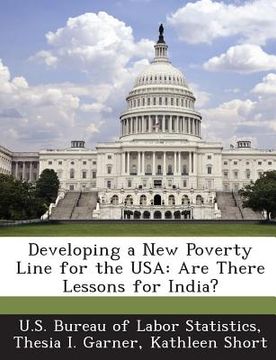Share
Developing a New Poverty Line for the USA: Are There Lessons for India? (in English)
U. S. Bureau of Labor Statistics
(Author)
·
Thesia I. Garner
(Author)
·
Kathleen Short
(Author)
·
Bibliogov
· Paperback
Developing a New Poverty Line for the USA: Are There Lessons for India? (in English) - Garner, Thesia I. ; Short, Kathleen ; U. S. Bureau of Labor Statistics
$ 13.26
$ 15.75
You save: $ 2.49
Choose the list to add your product or create one New List
✓ Product added successfully to the Wishlist.
Go to My WishlistsIt will be shipped from our warehouse between
Monday, July 08 and
Tuesday, July 09.
You will receive it anywhere in United States between 1 and 3 business days after shipment.
Synopsis "Developing a New Poverty Line for the USA: Are There Lessons for India? (in English)"
This paper reviews a procedure that is being followed in the United States of America (USA) to experimentally test and evaluate recommendations made for redefining poverty measurement in that country. The recommendations were made in 1995 by the US National Academy of Sciences (NAS) Panel on poverty measurement. In this paper these recommendations are reviewed and the impact of implementing the recommendations on measures of inequality and poverty are examined. In conclusion, a discussion concerning possible lessons for India is provided. The recommended poverty measure (based on new measures of thresholds and resources) is examined in terms of its impact on inequality statistics, as well as poverty statistics, and results are compared to similar statistics based on the official measure. The standard Gini index, and three generalized entropy inequality measures are used to examine inequality. For the poverty analysis simple head count ratios, poverty gaps, and Foster-Greer-Thorbecke poverty measures are computed. Data from the 1991 U.S. Consumer Expenditure Survey (CE) Interview are used to produce the thresholds, and data from the 1992 through 1997 Current Population Survey (CPS), and in some analyzes, the 1991 panel of the Survey of Income and Program Participation (SIPP), are used to define resources. The proposed measure produces a distribution of resources that is, in general, more equal than is the distribution of official income. The poverty analysis reveals that changes in the poverty rates based on the official and the experimental measures are similar over time. However, poverty as measured by the NAS measure is greater than official poverty. The experimental poverty measure yields a poverty population that looks slightly more like the total U.S. population in terms of various demographic and socioeconomic characteristics than does the current official measure.
- 0% (0)
- 0% (0)
- 0% (0)
- 0% (0)
- 0% (0)
All books in our catalog are Original.
The book is written in English.
The binding of this edition is Paperback.
✓ Producto agregado correctamente al carro, Ir a Pagar.

